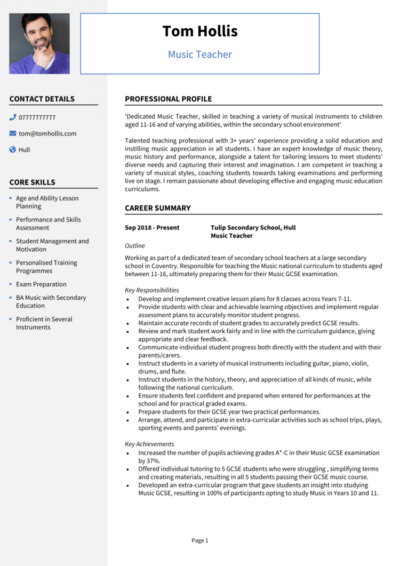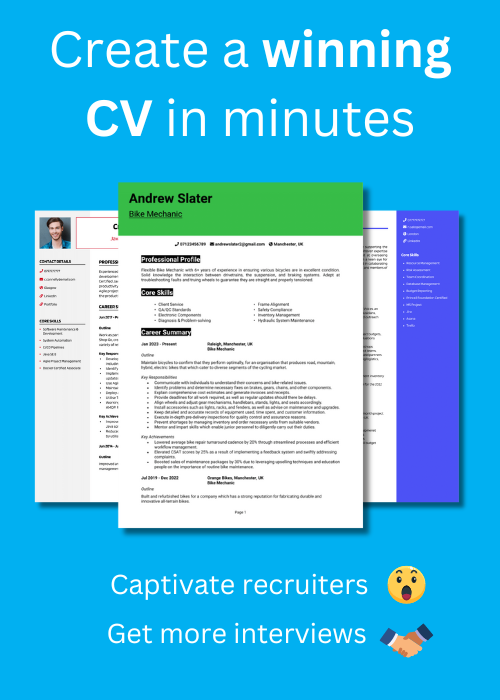Within minutes of the bell ringing, you’ve got a class of students reading notation, clapping rhythms, and maybe (just maybe) hitting the right notes.
It’s clear you know how to handle a classroom. Now, it’s time to prove it on paper.
This guide with 3 Music Teacher CV examples will show you how to compose a CV that hits all the right notes – so you can secure interviews and land the teaching job you’ve been working towards.
Music Teacher CV

Guitar Teacher CV
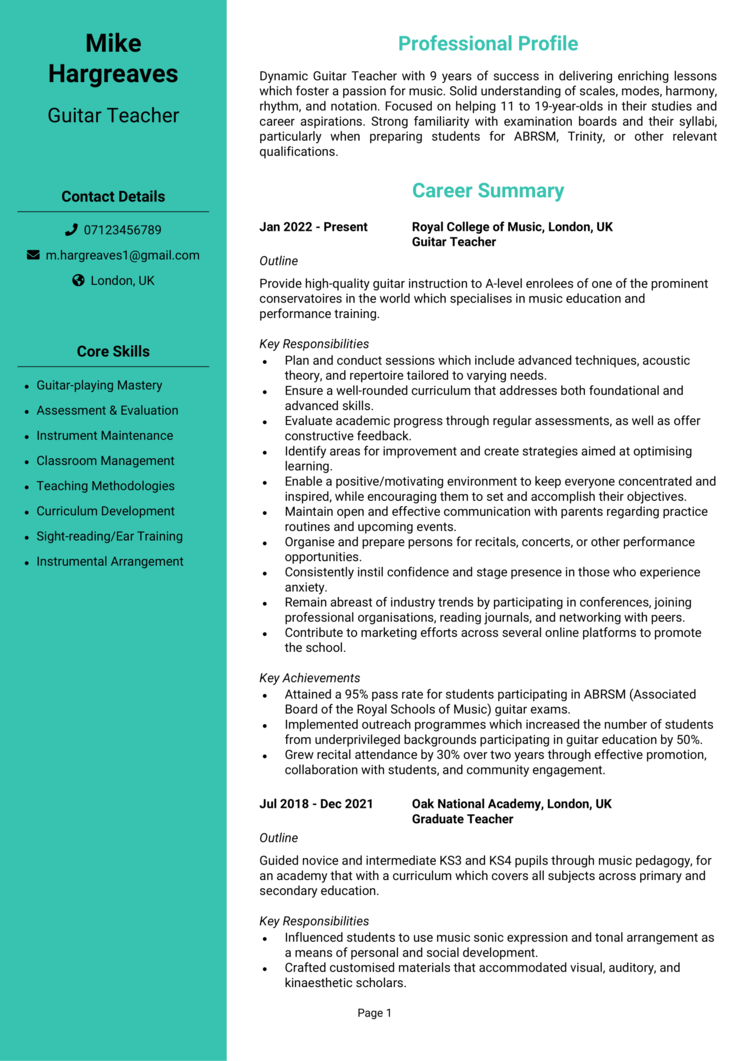
Piano Teacher CV
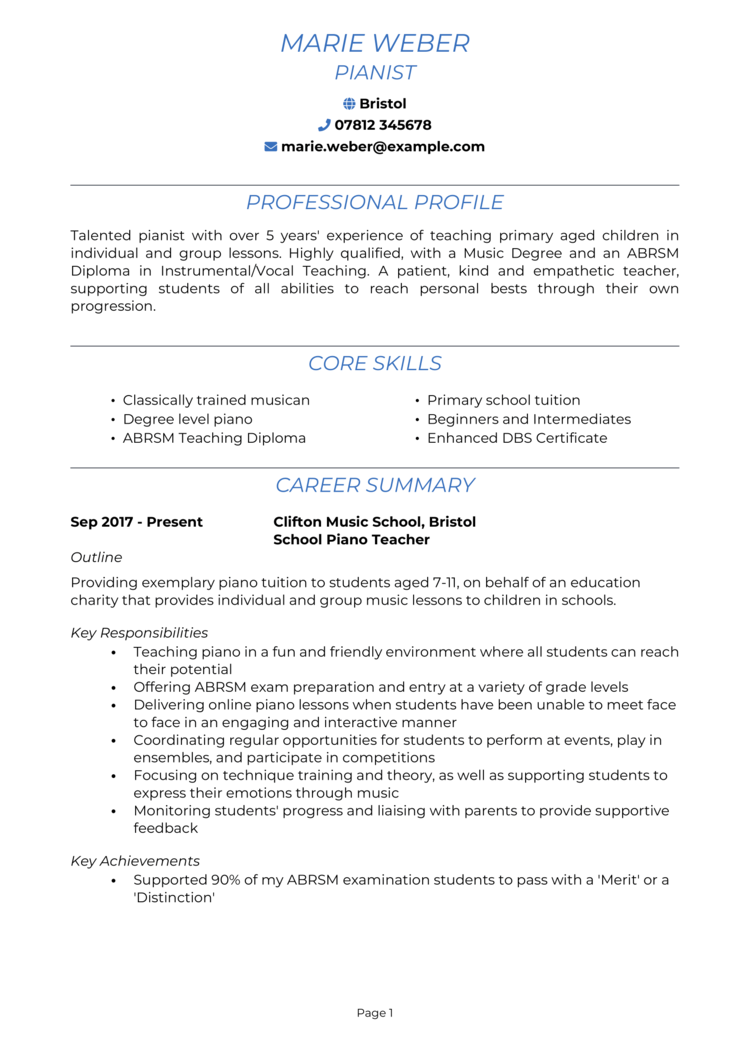
How to write your Music Teacher CV
Discover how to craft a winning Music Teacher CV that lands interviews with this simple step-by-step guide.
This guide will take you step-by-step through writing a CV as a music teacher. From presenting your teaching experience to emphasising your musical qualifications and classroom skills, you’ll learn how to hit every key area recruiters want to see.
Whether you’re teaching in primary schools, secondary schools, colleges, or private academies, this guide will help you showcase your range as both an educator and a musician.
The best way to structure and format your Music Teacher CV
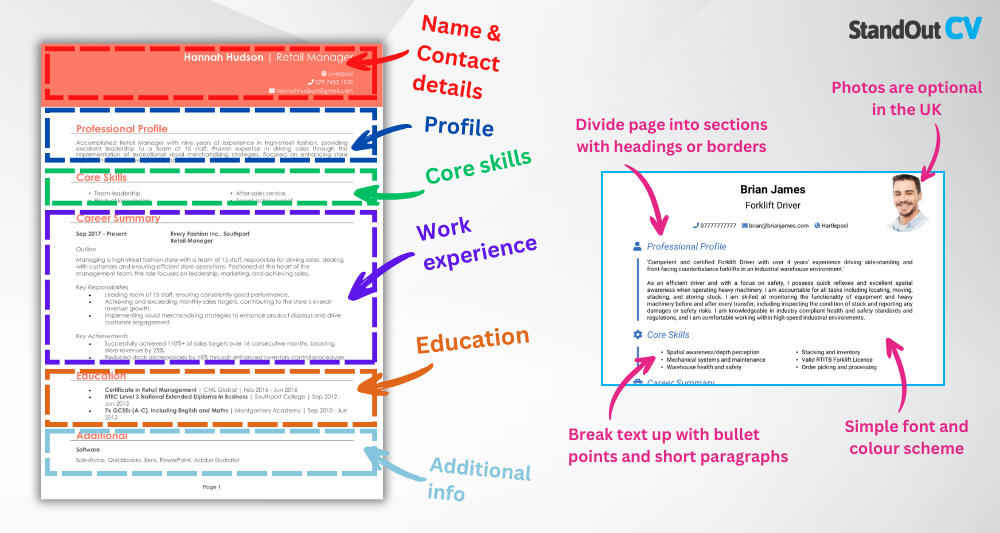
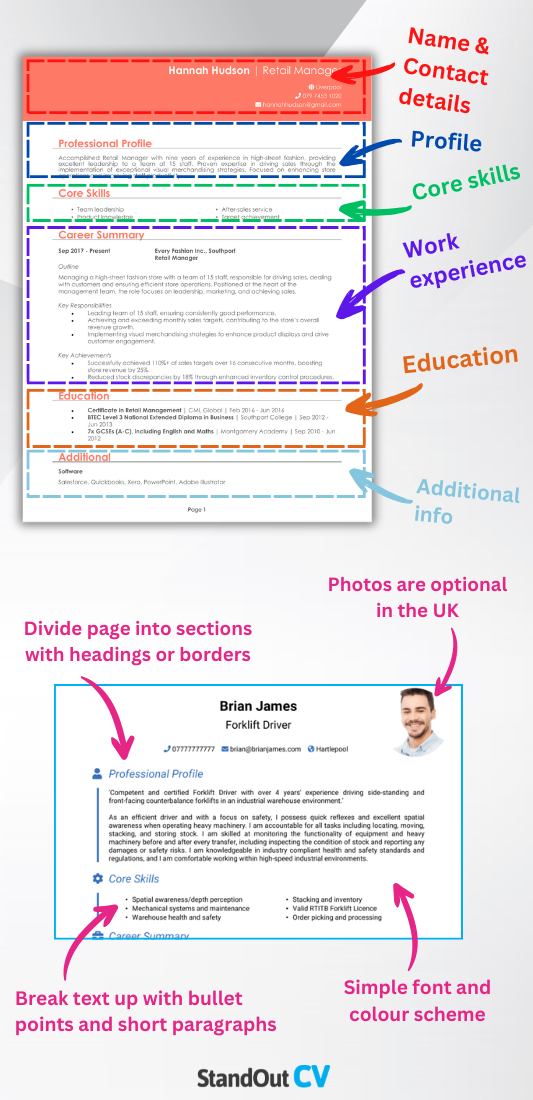
A good CV, much like a great lesson plan, needs rhythm, structure, and a clear sense of flow. Think of your CV like a musical score – if it’s hard to follow and full of mistakes, the reader will struggle to stay in tune with your message. Recruiters should be able to scan it quickly and get a clear sense of your teaching experience and musical strengths.
Here’s the layout to follow:
- Name and contact details – Place your personal details at the top so employers can get in touch easily.
- Profile – Kick things off with a concise overview of what makes you the ideal candidate for the job.
- Core skills – Briefly highlight those qualities which make you the best candidate.
- Work experience – List your previous roles in reverse chronological order, with your most recent first.
- Education – Go through the academic history which underpins your expertise.
- Additional info – This optional section can include professional memberships, awards, or hobbies and interests that showcase your suitability for the role.
Use bullet points to break down your experience into digestible highlights, and bold section headings to make each area distinct and easy to find. Choose a clean, legible font – not a jazzy one – and make sure your CV length doesn’t exceed two pages. A neat format not only shows professionalism, but also reflects the same structure and clarity you bring to your classroom and lesson delivery.
What is a Music Teacher CV profile?


Your CV profile is your opening number – the moment to captivate the audience and give them a reason to keep reading. This short paragraph should strike the right balance between teacher and performer, showing how you blend subject expertise with an ability to inspire.
It’s not just about what you’ve taught – it’s about how you’ve built students’ confidence, created memorable performances, and turned musical theory into something students genuinely care about.
Music Teacher CV profile examples
Profile 1
Dedicated Music Teacher with over 10 years of experience delivering instrumental and classroom music tuition across primary and secondary education. Experienced in preparing students for graded music exams, school concerts, and curriculum-based assessments. Known for creating inclusive, engaging lessons that foster musical confidence and creativity.
Profile 2
Experienced Music Teacher with six years working in both state and independent schools, delivering KS3, GCSE, and A-level music. Proficient in piano, guitar, and vocal instruction, with a track record of improving student performance in both academic and practical music settings. Passionate about developing well-rounded musicianship and critical listening skills.
Profile 3
Creative and enthusiastic Music Teacher with five years of experience leading music provision in schools and after-school programmes. Skilled in classroom teaching, ensemble leadership, and one-to-one tuition. Confident using technology such as Sibelius, Logic Pro, and Google Classroom to enhance learning and composition work.
Details to put in your Music Teacher CV profile
Make sure to include:
- Where you worked – Note whether you’ve taught in primary schools, secondary schools, academies, or private tuition
- Your top qualifications – Include your QTS status, PGCE, degree in Music, or specialist teaching certificates
- Essential skills – Classroom management, lesson planning, instrumental instruction, exam prep (e.g. ABRSM, Trinity)
- Musical focus – Highlight genres, instruments taught, or ensemble experience (choirs, bands, orchestras)
- Teaching strengths – Mention things like creating inclusive lessons, improving student performance, or running extracurriculars
How to highlight your core skills


This section gives hiring managers a quick look at your strongest teaching and musical abilities. List CV skills which highlight both your classroom strengths and your musical expertise.
Tailor this section to each role – one school might prioritise performance coaching, another might want curriculum planning or experience with SEND students.
Focus on specific teaching-related skills and avoid vague claims like “enthusiastic” or “passionate” – let your skills do the talking.
Essential skills for a Music Teacher CV
- Music Theory and Notation Instruction – Teaching students how to read, write, and understand musical notation and theoretical concepts.
- Instrumental and Vocal Training – Providing individual or group lessons in instruments such as piano, guitar, or voice to develop technical skills.
- Curriculum Planning and Lesson Design – Creating structured lesson plans aligned with national music education standards and student abilities.
- Performance Preparation and Direction – Coaching students for recitals, exams, and ensemble performances, including conducting and stage management.
- Aural Skills Development – Training students to identify pitch, rhythm, intervals, and chords by ear to strengthen musical perception.
- Classroom and Behaviour Management – Maintaining an engaging and respectful learning environment that encourages creativity and participation.
- Music History and Appreciation – Introducing students to a wide range of musical genres, styles, and cultural contexts.
- Technology Integration in Music Education – Using software and digital tools like GarageBand, Sibelius, or DAWs to support composition and learning.
- Assessment and Progress Reporting – Evaluating student performance through practical and written assessments and providing feedback to students and parents.
- Ensemble Leadership and Collaboration – Directing choirs, bands, or orchestras and fostering teamwork and musical collaboration among students.
How to showcase your work experience in your CV


This is where you demonstrate how you’ve inspired students, managed lessons, and delivered music education that sticks. Whether you’ve taught in a formal classroom or run private music lessons, each entry should clearly explain your role and the impact you had.
List your work experience in reverse chronological order, starting with your most recent position. Use bullet points under each job to make it easy to scan and focus on outcomes – not just responsibilities.
And don’t forget: running choirs, arranging performances, or even leading school productions all count as experience worth sharing.
How to format previous jobs in your CV correctly

- Outline – Describe the school, age group taught, and your role within the department – for example, “Music Teacher at a secondary academy teaching KS3 to KS5 and leading GCSE prep.”
- Responsibilities – Use action verbs like “delivered” and “arranged.” For example: “delivered curriculum-based lessons across KS3–KS4” or “arranged end-of-year concerts and ensemble performances.” Mention classroom management, teaching tools, or exam boards used.
- Achievements – Highlight your achievements and impact with specific results: improved student grades, successful concert performances, or high ABRSM pass rates. Where possible, use numbers or outcomes (e.g. “raised GCSE music pass rate from 68% to 89%”).
Example work history for Music Teachers
Music Teacher | Heathfield Secondary School
Outline
Delivered music education across KS3 and GCSE levels for a large state secondary school, supporting the full national curriculum and leading school performance events.
Responsibilities
- Planned and delivered engaging classroom music lessons using a range of instruments
- Prepared students for GCSE performance and composition assessments
- Directed school choir and organised termly concerts and recitals
- Used Sibelius and Logic Pro to teach composition and digital music skills
- Collaborated with colleagues on cross-curricular arts projects
Achievements
- Increased GCSE music uptake by 30% through curriculum revamp and enrichment
- Choir awarded first place in regional inter-school music festival
- Recognised for consistently high student feedback and lesson observation ratings
Music Teacher | St. Anselm’s Prep School
Outline
Taught classroom and individual music lessons to pupils aged 7–13 at a private preparatory school, with a strong focus on early musicianship and ensemble playing.
Responsibilities
- Delivered weekly lessons covering theory, performance, and listening skills
- Provided 1:1 piano and vocal tuition and supported students through ABRSM exams
- Directed orchestra and chamber groups for annual school productions
- Taught music reading, rhythm, and harmony through interactive methods
- Assisted with whole-school assemblies and event performances
Achievements
- Achieved 100% pass rate in music exams with over 60% achieving merit or distinction
- Expanded the school orchestra from 8 to 20 players within two years
- Helped students gain music scholarships to leading secondary schools
Music Teacher | Melody Futures Youth Programme
Outline
Led group and individual music sessions for a community-based organisation supporting access to music education for underprivileged youth.
Responsibilities
- Taught guitar, keyboard, and voice to students aged 8–16 with mixed ability levels
- Designed creative workshops blending music theory and songwriting
- Adapted teaching methods to support SEN and neurodiverse learners
- Planned end-of-term showcases to build student confidence and public speaking
- Maintained lesson records, attendance, and progress reports for funders
Achievements
- Helped 15+ students pass their first graded music exams within 18 months
- Built student retention rate to over 90% through engaging and supportive delivery
- Awarded community arts grant to expand the programme’s reach
Structuring your education section


Your education section should include your academic qualifications, teacher training, and any musical certifications. Schools want to see a blend of subject knowledge and teaching ability, so make sure both sides are represented.
List your qualifications in reverse chronological order. If you’re early in your career, you can also mention relevant modules or placements.
Top qualifications to showcase on a Music Teacher CV
- BA (Hons) or BMus in Music or Music Education – Provides subject knowledge across theory, performance, composition, and teaching practice.
- PGCE (Postgraduate Certificate in Education) – Required for teaching in most UK schools and shows formal training in lesson planning, assessment, and classroom management.
- QTS (Qualified Teacher Status) – The core requirement to teach in UK state schools.
- ABRSM/Trinity Performance Diplomas – Recognised certifications for instrumental and vocal proficiency, useful for exam prep and individual tuition.
- MA in Music Education – For advanced teaching roles or leadership in a music department.


